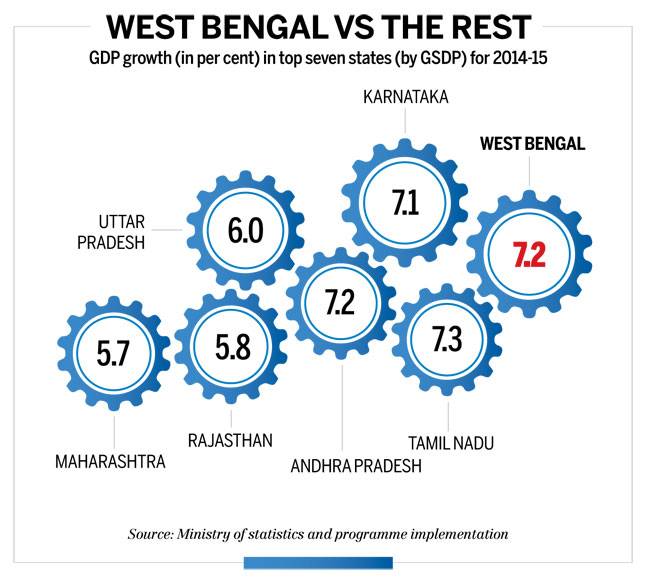West Bengal
This is a collection of articles archived for the excellence of their content. Readers will be able to edit existing articles and post new articles directly |
Contents[hide] |
The source of this article
INDIA 2012
A REFERENCE ANNUAL
Compiled by
RESEARCH, REFERENCE AND TRAINING DIVISION
PUBLICATIONS DIVISION
MINISTRY OF INFORMATION AND BROADCASTING
GOVERNMENT OF INDIA
West Bengal
Area : 88,752 sq km
Population : 91,347,736 (Prov. Census 2011)
Capital : Kolkata
Principal Language : Bengali
History
The name of Bengal or Bangla is derived from the ancient kingdom of Vanga, or Banga. In early Sanskrit literature references to the name of Banga occur, through its early history is almost obscure until the 3rd century BC. However, Stone Age tools dating back 20,000 years have been excavated in the State. Remnants of civilization in this region date back four thousand years, when the region was settled by Dravidian, Tibet-Burman, and Austro-Asiatic peoples.
The region was a part of the Vanga kingdom of ancient India. The kingdom of Magadha was formed in the 7th century BC, consisting of the Bihar and Bengal regions. It was one of the four main kingdoms of India at period of Mahaveera and Buddha, and was consisted of several Janapadas. During the rule of dynasty, the Magadha Empire extended over nearly all of South Asia, including Afghanistan and parts of Persia under Ashoka the Great in the 3rd century BC. Bengal was referred to as Gangaridai by the ancient Greeks around 100 BC, meaning, speculatively, a land with the river Ganga in its heart. From the 3rd to the 6th centuries AD, the kingdom of Magadha served as the seat of the Gupta Empire. The first recorded independent king of Bengal was Shashanka, reigning around the early 7th century. After a period of anarchy, the Buddhist Pala dynasty ruled the region for four hundred years, followed by a shorter region of the Hindu Sena dynasty.
During the 12th century Islam made its first appearance in Bengal when the Sufi missionaries arrived. Later, occasional Muslim raiders reinforced the process of conversion by building mosques, madrassas, and Sufi Khanqahh. During the 14th century, the former Kingdom became known as the Sultanate of Bengal, ruled intermittently with the Sultanate of Delhi. Bengal was ruled by various Muslim rulers and governors till the Mughal period in the 16th century.
After the Mughals, history of modern Bengal begins with the advent of Europeans, more precisely, with the English trading companies. The battle of Plassey in 1757 changed the course of history when the English first gained a strong foothold in Bengal and India as well. Bengal was partitioned in 1905 to achieve some political returns, but people's growing movement led to the reunion in 1911, under the auspices of the Congres. This triggered off pectic movement for freedom which culminated with the Independence in 1947, and partition.
After 1947, the merger of native princely States began which ended with its final reorganisation in 1956 (as per Recommendations of the States Reorganisation Act, 1956) when some Bengali speaking areas of a neighbouring State were transferred to West Bengal.
The land frontiers of the State touch Bangladesh in the east and are separated from Nepal in the west, Bhutan lies in the north-east, while Sikkim is on the north. On the west are the States of Bihar and Jharkhand, while in the south lies Odisha, and the Bay of Bengal washes its southern frontiers.
Economy
2011-15: Key indicators
The Times of India, Apr 16 2016

Reading the signs of Bengal's job distress
Subodh Varma As West Bengal readies for the next round of voting, the electorate is brooding over the balance sheet of five years of `poriborton' that a rampant Mamata Bannerjee had promised in 2011. She swept the polls dislodging the Left Front after nearly 35 years then. This time the path is seemingly more difficult and the voters sullen.
A key factor for people's disappointment is the stark employment situation. Disregarding the unsourced big numbers doled out by ministers, all other government validated data points to a sluggish and faltering economic situation. Average yearly growth in agriculture between 2011-12 and 2014-15 (the last year for which data is available) was a mere 1.7%.This is more than what was registered under the preceding four-year period under Left Front -but insufficient to boost employment.
One measure of rural unemployment and distress is the number of people wanting work under the job guarantee scheme.Data for the past four years is deeply worrying for Bengal.Last year, over 65 lakh households -representing at least 3 crore people -applied for work under MGNREGS, as per government records.
This is the country's highest, even higher than more populated states such as UP , Maharashtra and Bihar. Considering the scheme provides only about 48 days of work in a year, and the work is backbreaking manual labour, the high numbers only speak of one thing: other work is scarce in the rural areas.
It may be argued that high demand is because the scheme is efficiently implemented. But a look at the scheme's other as pects will reveal the contrary .Just 4.4% of the works started in 2015-16 have been completed and over 71% of wages are delayed by over two weeks, 48% by over four weeks.
Clearly, it is just work demand that's filling up paper, for, neither is there any output nor are people getting much needed cash on time. The Centre has undoubtedly contributed by not releasing funds in time but the numbers demanding work reflect the state's economic plight.
If this is the jobs situation for agriculture that's grown a bit under TMC rule, the real crunch is in industry and services. Reports of closures of industrial units including jute are forming a trend that's led to a slowdown in manufacturing in the past four years compared to the preceding period. Industry has grown by 5.8% compared to 3.5%, but this derives from a growth in construction -flyovers, roads -and in unregistered manufacturing. Both are low paying, seasonal and uncertain jobs.
Agriculture
Agriculture is the main source of income for about 70 per cent of the population. Jute and rice are the principal crops grown in the State, along with tea, maize tobacco and sugarcane. The State Government is concerned with activities relating to policy decisions on agricultural producing and productivity, and its extension through technology generation, transfer of technology, ensuring availability and timely distribution of agriculture inputs specially seeds, fertilizers, subsidy, credit etc. along with support service through soil testing, soil conservations, water conservations, seed testing, seed certification, plan production, quality control of fertilizers and pesticides etc.
Flora
Medicinal plants under threat
Shiv Sahay Singh, Bengal’s medicinal plants face threat, July 16, 2017: The Hindu
Forest Department has documented 581 of these species in a unique 600-page-volume
The West Bengal Forest Department came out with a unique publication that provides details on 581 species of medicinal plants found across different regions of south Bengal.
The plants are being conserved in situ, that is, where the plants are naturally found, at four medicinal plant conservation areas (MPCA) across south Bengal — Bonnie Camp MPCA South 24 Parganas district, Kakrajhore MPCA at Janagal Mahal in the south-western part of the State, Garh Panchkot MPCA in the Panchet foothills in the Purulia district, and Susinia MPCA located in Bankura near Raghunathpur.
Collections from two ex-situ (conserving in an area where the plants were not originally found) conservation sites at the Amlachati Medicinal Plant Garden about 20 km from Jhargram town and the Digha Medicinal Plant Garden at the Purba Medinipur district have also been included in the 600-page book titled Medicinal Plant Resources of South Bengal.
Out of 20,000 medicinal plants listed by the World Health Organisation (WHO), India’s contribution is about 5,000 species. “The publication lists 581 species, which means that one of every 10 species of medicinal plants found in India have been listed in the book,” Santhosha G. R., Divisional Forest Officer, Midnapur Silviculture Division, told The Hindu.
Brink of extinction
Mr. Santhosha emphasised that increasing use of medicinal plants as raw materials by different pharma companies has pushed many of these species to the brink of extinction.
Stating that the volume will help scientists, foresters, researchers and Ayurveda practitioners, N. K. Pandey, Principal Chief Conservator of Forests, West Bengal, said that the publication is part of ongoing measures taken up by the State Forest Department to conserve medicinal plants.
A large number of plants compiled in the book are from the Amlachati Medicinal Plant Garden, which boasts of the largest collection of medicinal plants in the country, though it is located in a small area comprising of a few hectares of land. The publication lists medicinal plants in alphabetical order as per their scientific names. For instance, it provides details of three species of asparagus, a climber: Asparagus adscendens, Asparagus officinalis and Asparagus racemosus. All three species are found across south Bengal.
According to the authors of the book, while Asparagus officinalis is used for the treatment of jaundice and rheumatism, Asparagus racemosus is not only used to treat human ailments but also that of cattle, and is sold in the markets of south Bengal by locals.
Significant uses
The roots of a rambling herb Gloriosa superba found across south Bengal are poisonous, but they have certain anti-carcinogenic and anti-malarial properties and are widely sought by pharma companies.
The bark of the medium-sized evergreen tree Saraca asoca (commonly called Asok tree), which is a threatened tree species classified as ‘Vulnerable’ on the International Union for the Conservation of Nature’s (IUCN) Red List, is used in the treatment of a number of ailments, including heart disease.
One of the authorssaid that sloth bears are reported to feed on the pulp of the Cassia fistula (amaltus) fruit for stomach ailments. The plant also has medicinal properties for treating skin diseases in humans.
“The publication will not only serve as a very important data bank of medicinal plants in the country, but will also generate interest among common people to come forward and conserve medicinal plans by growing them into their home gardens,” Mr. Santhosha said.
Industry
The salient features of the State policy on industrial promotion and economic development are to welcome foreign technology and investment, private sector investment in power generation, improvement and upgradation of industrial infrastructure. The thrust areas are petrochemicals and downstream industries, electronics and information technology, iron and steel, metallurgical and engineering, textile, leather and leather products, food processing, medicinal plants, edible oil, vegetable processing and aquaculture.
In the recent years the flow of investment in the districts like Bankura, Midnapur, Burdwan and Purulia has been quite impressive. The effort of the State Government to accelerate investment in the State has reflected in investment proposals through IEMs. During 2010, West Bengal received 209 IEMs with investment proposals of Rs. 42,765 crores and employment potential of 58859 persons.
Major investments are taking place in mine, steel plants, forging, pig iron etc.
The easy availability of power, removal of freight equalization, close proximity to areas with natural resources relevant to the industry, and a labour force traditionally skilled in operating iron and steel units are factors that have influenced the surge in investment in this sector. In recent years, investment in the chemical and cement industry has also picked up too.
The State Government is focused on developing Special Economic Zones (SEZs). It encourages hassle free manufacturing and trading for export promotion. Around 80 per cent investment takes place in IT/ITES sector and 2 per cent in biotech sector. In West Bengal, there are 5 functional SEZs—Falta (multi products), Manikanchan (gems & jewelry), WIPRO (ITeS), Dalmiya & Co Ltd. (Leather, IT/ ITeS)) and Unitech High (IT/ITeS).
An airport city (Aerotropolis) is coming up in the Durgapur-Asansol region in Bardhaman district. The estimated project cost is Rs. 10,000 crores and is expected to be completed by 2015. The project area consists of an Airport, IT & Industrial Park, Institutional Area, Supporting Township and Rehabilitation & EWS Zone. The chemical and petrochemical sector is also an important area of investment in the State. The State has received approval from the Central Government for setting up Petroleum, Chemical and Petrochemical Investment Region (PCPIR) in the existing Haldia mainland and additional processing area in Nayachar Island.
Proposed investment for infrastructure development of Nayachar island is approximately Rs. 8,400 crore with employment potential of 50,000 persons. Dishergarh Power Supply Co. Ltd. (DPSCL) has proposed to set up a 2x270 MW thermal power plant at Raghunathpur Industrial Park. The proposed investment of the project is Rs. 3024 crore.
The Food Processing Industries & Horticulture Department of the State Government promotes food-processing industries in the State.
The State has identified the Information Technology (IT) sector as a priority sector for growth. The IT Hub at Salt Lake in Kolkata is India's first fully integrated electronic complex spread over 150 acres of green, pollution free area near airport.
Power and irrigation
State, Central and Private Utilities constitute a vibrant power sector in West Bengal. West Bengal State Electricity Distribution Company Limited (WBSEDCL), West Bengal State Electricity Transmission Company Limited (WBSETCL), West Bengal State Electricity Transmission Company Limited (WBSETCL), West Bengal Power Development Corporation Limited (WBPDCL) and Durgapur Projects Limited (DPL) are in the State Sector. CESC Limited and Dishergarh Power Supply Company Limited (DPSC) are positioned in the private and joint sector respectively. The State also receives Central Sector power allocations from National Thermal Power Corporation (NTPC) and National Hydel Power Corporation (NHPC) plants in the East/North-east and through bilateral understandings from DVC.
Peak demand in the State at present is nearly 6000 MW. It is growing steadily over the years. Most of the demand in the State is met by thermal power. The total installed capacity of WBPDCL is around 3610 MW, DPL 641 MW and CESC 1225 MW. A unique project of its kind, the 4x225 MW Purulia Pumped Storage Project under WBSEDCL, plays a significant role in peak demand management in the State. Apart from these, there are solar, wind, hydro and biomass based power plants established by the West Bengal Renewable Energy Development Agency (WBREDA) and captive generation units set up by various industrial houses. Further, West Bengal Green Energy Development Corporation Limited (WBGEDCL) was established some time back with the objective of promoting investment in Gridconnected renewable energy projects and in various green energy sources. The other objective is to develop and execute special renewable energy projects on commercial basis.
Transport
Transport Department looks after provision of transport facilities and infrastructure on road, inland water and air—within the domain of State Government. It also provides administrative and legal framework for the same. Its activities include issue of licenses and permits. The length of roads as on 31st March, 2002, has been 91,970 km including 1898 km of National Highways. The length of roads under State Highway is 3533 km, under PWD 12,565 km and that of the district roads 42,479 km respectively.
Tourism
Tourism has emerged as one of the largest service sector industries of the world. Internationally, this boom in travel and tourism industry is expected to continue, and will be an opportunity for every region in the world to be part of this process. India is also becoming a leading international tourist destination. Against this backdrop, the Department of Tourism in West Bengal has been making concerted efforts to boost the tourism industry in the State. West Bengal is endowed with distinct natural attractions like impressive mountain ranges, virgin forests, variety of wild life, verdant tea gardens, meandering rivers, sandy beaches and the world's largest mangrove forests, the Sunderbans. Along with these, the State also has a rich tradition of art, craft, culture and cuisine. All these facets, together, make West Bengal a highly potential tourist destination.
Culture: Dances and festivals
Gomira mask makers
Shiv Sahay Singh, Last of the Gomira mask-makers see silver lining, July 9, 2017: The Hindu
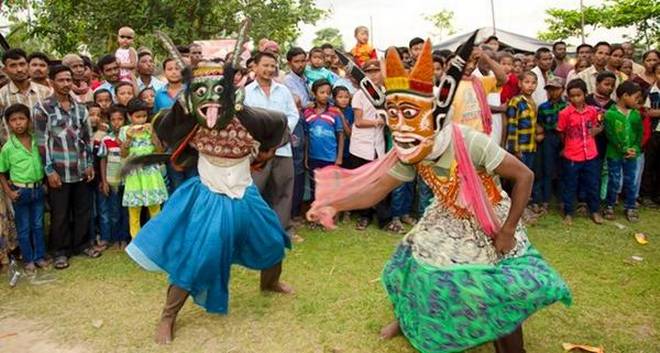
Art of producing colourful wooden masks has been revived in Kushmundi, and demand for them is global
Till 2013, Sankar Das, a skilled craftsman carrying forward the 300-year-old tradition of making the unique Gomira wooden masks in north Bengal, lived in obscurity. A native of Kushmundi block in West Bengal’s Uttar Dinajpur district, he was among the 200-odd artisans making a living creating these masks for the annual Gomira dance festival held in and around the village.
However, in 2013, after a memorandum of understanding was signed between the West Bengal government and UNESCO to promote culture-based livelihoods, things began to change for the better for these mask-makers.
“Earlier I used to come to the annual crafts fair in Kolkata once a year to sell my masks. Now, with the demand increasing, we are getting orders not only from other cities but also from across the world. I went to France in 2015 and to the United Kingdom in 2016,” Das told The Hindu.
The 41-year-old artist, who said he has been associated with mask-making for three decades, admitted that had it not been for the support of the government, the art of Gomira mask-making and its traditions would have gone extinct.
According to Banglanatak.com, a social enterprise that partners with UNESCO in capacity building among the mask-makers at the ground level, a survey carried out in 2015 pointed out that not only had the number of masks made by the artists increased, but also the number of days a craftsman put in to prepare the masks had risen from seven to 30 in a month.
Festival to promote art
“Since 2013, a number of initiatives have been taken, which include setting up a training-cum-resource centre at Kushmundi and organising a village folk festival every year. For instance, this year, the festival to promote mask-making will be held from October 27 to October 29,” said Ananya Bhattacharya, director and vice president (projects), at Banglanatak.com.
Government
Governor : Shri M.K. Narayanan
Chief Secretary : Shri Samar Ghosh
Chief Minister : Km. Mamata Banerjee Jurisdiction of High Court: West Bengal and Andaman & Nicobar Islands
DISTRICT WISE POPULATION IN WEST BENGAL S.No. District Total (Prov. 2011) Male Female
1. Darjeeling 18,42,034 9,34,796 9,07,238
2. Jalpaiguri 38,69,675 19,80,068 18,89,607
3. Koch Bihar 28,22,780 14,53,590 13,69,190
4. Uttar Dinajpur 3000849 15,50,219 14,50,630
5. Dakshin Dinajpur 16,70,931 8,55,104 8,15,827
6. Maldah 39,97,970 20,61,593 19,36,377
7. Murshidabad 71,02,430 36,29,595 34,72,835
8. Birbhum 35,02,387 17,91,017 17,11,370
9. Barddhaman 77,23,663 39,75,356 37,48,307
10. Nadia 51,68,488 26,55,056 25,13,432
11. North Twenty Four 1,00,82,488 26,55,056 25,13,432 Parganas
12. Hugli 55,20,389 28,19,100 27,01,289
13. Bankura 35,96,292 18,40,504 17,55,788
14. Puruliya 29,27,965 14,97,656 14,30,309
15. Haora 48,41,638 25,02,453 23,39,185
16. Kolkata 44,86,679 23,62,662 21,24,017
17. South Twenty Four 81,53,176 41,82,758 39,70,418 Parganas
18. Paschim Medinipur 59,43,300 30,32,630 29,10,670
19. Purba Medinipur 50,94,238 26,31,094 24,63,144
Total 9,13,47,736 4,69,27,389 4,44,20,347
Health
2016: A crumbling sector
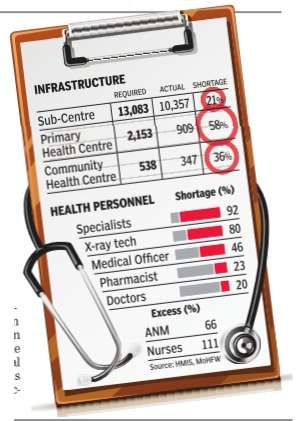
The Times of India, Apr 21 2016
Poll silence on Bengal's crumbling health sector
Subodh Varma Bagnan, in Bengal's Howrah district, has a distinction. The government rural hospital here is the state's only facility to have a five-star rating awarded for service quality , infrastructure, availability of medicines and staff.
Block medical officer Dr Palas Kumar Mallik says cleanliness, use of generator and presence of an obstetrician for Caesarean sections got them the top rating. Why is this unique?
Shouldn't hospitals have such facilities in any case? Not in Bengal. The rating system couldn't award any star to 265 of the state's 399 community health centres and rural hospitals because they didn't meet even one criterion. Only 54 centres got four stars, the rest were three-star or below.
Not many parties are talking of the state of healthcare delivery in Bengal's bitter election battle. But it's an issue weighing on the minds of people. According to a 2015 NSSO report, Bengal has one of the highest rates of people reporting ailments 16% of the population, exceeded only by Kerala (31 %).
Bengal has another striking feature: 77% males and 78% females falling sick went to private doctors. For men, this is the second highest share, exceeded only by Bihar. For women, it's the country's highest.Others with such high rates were UP , Bihar and Chhattisgarh.
What's common between Bengal and these states? It's the poor government health infrastructure forcing people to seek more expensive private doctors.
Take physical infrastructure. Government data shows that the three-tier structure of sub centres (SC) in villages, primary health centres (PHC) above them for a cluster of villages, and community health centers (CHC) covering many villages, are in a dis mal state in Bengal.
The very number of these outposts is short, causing overcrowding and poor delivery . While SCs are 21% short, PHCs are less than half the number required and CHCs are a third short.
Key health personnel are equally in shortage, but some types are in excess.
Doctors are 20% short, surgeons, pedia tricians, obstetri cians are short by a shocking 92%, gener al-duty medical officers are 46% less and X-Ray technicians 80% short of require ment. Bagnan is a rare CHC where an obstetrician is available. But the state has deployed 66% extra auxiliary nurse cum-midwives (ANMs) and a staggering 111% more nurses in the field. This is probably because their training and re cruitment is done locally . In the absence of qualified doctors the para-medical staff is shouldering the load.
Through paramedical staff, and be cause of awareness, fertility rate in Bengal has dropped steeply for many years and stands at 1.8. Infant mortality has fallen to 27 deaths per 1,000 live births. But the tottering health infrastructure will cast a long shadow. According to the National Family and Health Survey (NFHS), in 2015, 22% of 12-23 month old infants hadn't been fully immunized in urban areas. This share was 13% in villages.
Then there's poverty which pushes children and their parents towards malnutrition and ill-health. Just about 20% infants were getting adequate diet, 32% were underweight and 54% children up to 5 years old were anemic. In the 15-49 years age bracket, 63% women and 30% men were anemic. This is the foundation of ill-health on which Bengal stands, and the healthcare system is inadequate to deal with it. Will this election throw up an answer?
Population
Religion-wise, 2011
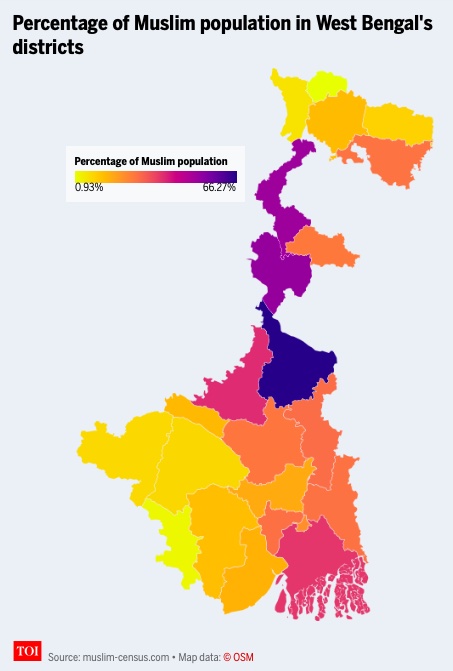
From: Prabhakar Jha, March 26, 2021: The Times of India
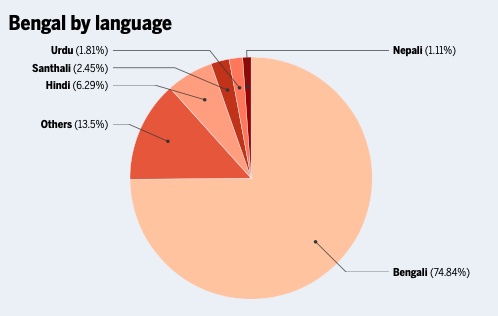
From: Prabhakar Jha, March 26, 2021: The Times of India
See graphics:
Percentage of Muslim population in West Bengal's districts, 2021
West Bengal by language, 2021
Bengal or ‘West’ Bengal?
The Times of India, Aug 03 2016
The Mamata Banerjee cabinet resolved to change the state's name, dropping the “West“ to call it simply “Bengal“ (in English). In Bengali, the state will now be called “Banga“ or “Bangla“ instead of “Paschimbanga“.
The advantages of the proposed name change are practical and obvious.
The proposed name starts with “B“ instead of the current “W“ so official representatives of the state will not have to twiddle their thumb, waiting for their turn to present the state's case in all-India meetings (the latest victim has been chief minister Mamata Banerjee herself, at the recent InterState Council meeting).
This is the third attempt to change the state's name in the last 17 years -it started with the Jyoti Basu government's effort in 1999. The bid to change the name of the state caps a long history of nomenclature changes of the region that happened naturally over several centuries. But both the attempts of the last 17 years have been still-born -more for political reasons -and politics may well play a determining role yet again, nixing the third attempt by this government.
The drawbacks of the proposed change would generate far greater debate. The “West“ in “West Bengal“ was a reaction to -and acts as a reminder of -the partition of undivided Bengal in 1905. A section of historians would not like the idea of dropping this; it would be an undesirable attempt at forgetting history.
The process that has to be followed is also much more daunting than the Bengal cabinet's Tuesday's statement of intent. The first experiment came in 1999, when CPM stalwart Jyoti Basu used to be the state's chief minister. But opposition from the Atal Behari Vajpayee-led BJP nixed that at tempt; the BJP, at that time, hated the idea of trying to forget that Bengal -once upon a time -was undivided.The same party , under a seemingly more hawkish dispensation, is again in office at the centre. All this counts; both houses of Parliament will have to ratify the state's decision by at least a two-thirds majority for the state's wish to be fulfilled.
The second attempt came in 2011, when the Mamata Banerjee government pitched for “Paschimbanga“ as the state's name after an all-party meeting. But this bid, too, got stuck in the corridors of power in Delhi because her relation with the Congressled UPA-II regime got more and more bitter (the issues ranged from the “centre's inaction against state-sponsored violence during Left rule“ to her opposition to the Lokpal Bill in Parliament despite being an UPA ally.
Wildlife parks and sanctuaries: India
BUXA NATIONAL PARK
Buxa National Park is famous for its wildlife. It is situated at the eastern Himalayan foothills. The forest is mainly moist deciduous with Sal as one of its predominant tree species. Elephant, Tiger, Leopard, Gaur, Sambar, Chital, Barking Deer, are large mammals found here. It borders Bhutan on the north and Manas tiger reserve on the east.
SUNDERBANS
Situated in the delta of the three major rivers - the Ganges, Brahmaputra, and Meghana, Sunderbans are swamp forests spread over nearly 1300.10 sq. km. area.
Sunderbans is predominantly a mangrove forest. Mangroves are ideal nurseries for diversity of aquatic fauna. Life within such forest is unique, teaming with diversity of fish, crabs, shrimps, lobsters, and a good number of birds, crocodiles. The islands formed by silt deposition, silt deposits along the coast are rich in nutrients, but loose wet soil restricts tall plant species growth. Hence, Sunderbans has nothing to offer in the name of big animals, but an abundance of smaller animals make it rich in biodiversity.
Sunderbans is well known for Tigers and the tiger here has adapted very well to the local conditions and feeds mainly on Wild boar, Deers, Monkeys, Birds, Fish, and Crabs. Confrontation with human beings is more of a possibility in the area as the tribals enter tiger territory in search of honey or even fuelwood.
A visit to Sunderbans can always be exciting not only for sighting Tiger but understanding the enthralling unique diversity of life that this mangrove forest sustains.
Gangetic dolphin, Porpoise, Chital, Wild boar, Jungle cats, Mongoose, Langur, Monkey, Fishing cats, are some of the common mammals found besides a variety of turtles, specially the endangered Olive Ridley turtle. Bird diversity is also very high.
Location
Baripada (50 km)
Area: 1300.10 sq. Km
Best time to visit: October to early June
Access
By Air: Jamshedpur (140 km), Bhubaneshwar (350 km), Calcutta (240 km)
By Rail: Jamshedpur, Bhubaneshwar and Calcutta
Accommodation
Forest Rest House
Contact
Field Director, Simlipal Project Tiger, Baripada Orissa - 757 002
